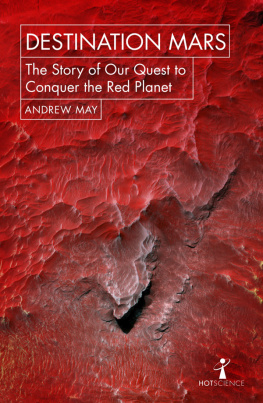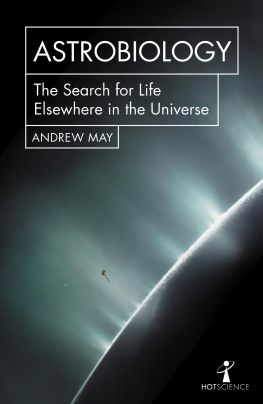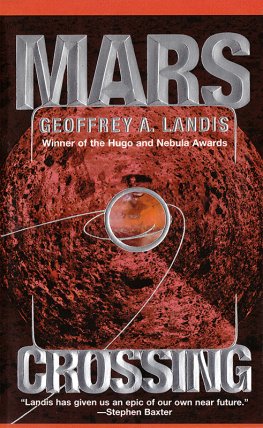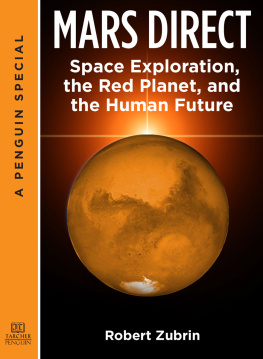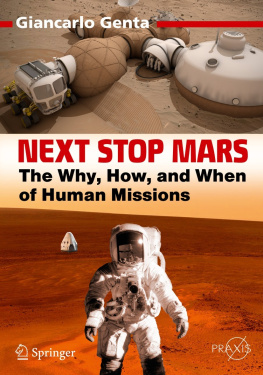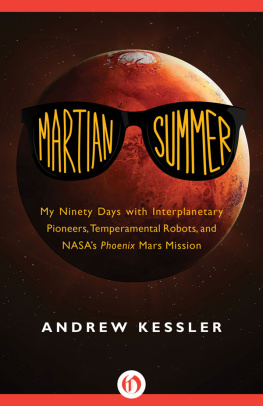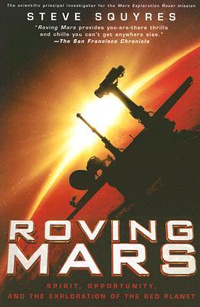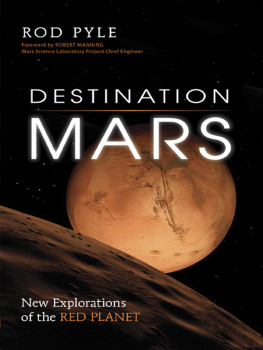DESTINATION
MARS
DESTINATION
MARS
The Story of Our Quest to
Conquer the Red Planet
ANDREW MAY

CONTENTS
PREFACE: FROM SCIENCE FICTION TO SCIENCE FACT
Its the year 2031. The six astronauts making up the crew of Ares 1 blast off into Earth orbit, where they proceed to link up with the recently completed Hermes Mars transit vehicle. Looking like a small-scale version of the ISS the International Space Station Hermes boasts something the ISS never had: a nuclear-powered ion engine. Nothing like as powerful as the chemical rocket that lifted the crew off the Earths surface, this is only capable of producing a tiny acceleration but its an acceleration that can be kept up for months on end. Thats enough to take Hermes all the way to Mars, putting it safely into orbit around the Red Planet later the same year.
All six crew members transfer to the small Mars descent vehicle, which takes them down to the surface. After entering the thin Martian atmosphere, their descent is slowed first by a large parachute like a Soyuz space capsule returning to Earth and then by a powerful downward-pointing rocket engine, like a scaled-up version of the one on the Apollo lunar lander. The Ares 1 crew dont just land anywhere, but in a carefully prepared spot. A series of earlier, uncrewed missions has already delivered everything they need for their 30-day stay, including a pressurised habitat with food, air and water, two surface rovers and a variety of scientific instruments. Most important of all, ready and waiting for them when they arrive is the Mars ascent vehicle, which has been busy making fuel for the trip back up to Hermes by mixing hydrogen with carbon dioxide from the Martian atmosphere.
This first human journey to Mars passes without a hitch, and the Ares 1 crew return safely to Earth to be followed two years later by Ares 2 on a similar mission. Then after another two years well, perhaps Ares 3 wont go quite according to plan. It doesnt in Andy Weirs 2014 novel The Martian, which was turned into a blockbuster movie by Ridley Scott the following year. Thats the source of the scenario thats just been described and for Weir and Scott it serves to set up one of the most exciting survival stories of modern times. But is it really just fiction?
Most of the technology portrayed in The Martian already exists. The Saturn V rocket of the 1960s could lift more than a hundred tonnes of payload into Earth orbit, and there are several launchers in development which will be able to match that. The 400-tonne ISS shows that its possible to build large-scale structures in Earth orbit and that humans can safely live and work in space for a year or more.
The huge, nuclear-powered Hermes spaceship seen in the movie is far more sophisticated than it needs to be (for a trip to Mars, that is its about right for a Hollywood blockbuster). The issue here, though, is one of unnecessary cost and extravagance rather than lack of technological feasibility. It would certainly be possible, for example, to produce artificial gravity by rotating parts of the spacecraft but whether thats necessary or cost-effective, on a mission designed to last little more than a year, is a different matter. ) type is technically feasible, and the subject of current research, but its probably unnecessary. Conventional rockets should be able to do the job well enough.
The crew-carrying Hermes would be preceded by various supplies sent in advance robotic missions of the kind that are already routinely sent to Mars whenever a launch window opens up. This split-mission approach was promoted in the 1990s by aerospace engineer Robert Zubrin, under the title Mars Direct which also included the idea of in situ fuel production, as portrayed in The Martian. With various permutations, Zubrins basic mission architecture is echoed in most current proposals for the human exploration of Mars, whether from government agencies like NASA or from private companies like Elon Musks SpaceX and of course in fictional portrayals like The Martian.
So a journey to Mars is technically feasible but is it going to happen in the next 20 years? During the 1960s, many people were confident there would be humans on Mars before the end of the 20th century. Sadly, that didnt happen, for a variety of reasons, ranging from money and politics to conflicting priorities within the space and science communities. Despite that, progress has been made. Weve got the football-field-sized ISS, maintaining a continuous human presence in space since the first year of this century. Weve seen NASA put the Curiosity rover a mobile science laboratory the size of a small city car on to the surface of Mars, and then drive it up the side of a mountain. And weve heard big-business entrepreneurs like Musk making bullish predictions about reaching the Red Planet on private funds alone. The race to Mars may have had a slow start, but its definitely hotting up now
__________
A list of abbreviations is included at the end of the book (see page 155).
THE LURE OF THE RED PLANET | 1 |
Our Solar System neighbour
May we attribute to the colour of the herbage and plants, which no doubt clothe the plains of Mars, the characteristic hue of that planet, which is noticeable by the naked eye, and which led the ancients to personify it as a warrior? Are the meadows, the forests, and the fields, on Mars, all red? The land cannot be all over bare of vegetation, like the sands of the Sahara. It is very probably covered with a vegetation of some kind, and, as the only colour we perceive on Marss terra firma is red, we conclude that Martian vegetation is of that colour.
So wrote the French astronomer Camille Flammarion in 1873. That was a time when telescope technology had just got to the point of discerning a few surface features on the Red Planet and people like Flammarion let their imaginations run wild. Their writings sparked a worldwide surge of interest in Mars, and before long its alleged red vegetation was joined by a complex system of artificial canals and malevolent bug-eyed monsters. It was just the latest phase in humanitys fascination with the Red Planet, which stretches back to antiquity.
Mars is one of Earths closest neighbours in space, the next planet out from the Sun. Before the invention of the telescope, it was one of just five planets that could be seen in the night sky. The others are Mercury and Venus, both orbiting closer to the Sun than Earth, and Jupiter and Saturn out beyond Mars. Only Venus ever gets closer to the Earth than Mars.
The Earths orbit takes it all the way round the Sun once a year. The orbit isnt a perfect circle, but its close enough, with an average radius of about 150 million kilometres. For convenience, this distance is sometimes referred to as an astronomical unit, or AU, to make it easier to compare distances within the Solar System. Venus, for example, travels around the Sun on a near-circular orbit of 0.72 AU radius, so its closest approach to Earth is just 0.28 AU, or about 42 million kilometres.
The situation with Mars is more complicated. Its orbit is distinctly non-circular an oval shape called an ellipse. Its distance to the Sun at perihelion, or closest approach, is only about four-fifths of that at aphelion, the furthest point of its orbit. Actually, all the planets move on elliptical orbits thats Keplers first law of planetary motion but in the case of Earth and Venus, perihelion is only slightly closer to the Sun than aphelion.
On average, Mars is about 50 per cent further from the Sun than Earth. It also takes significantly longer to complete an orbit, following the third of Keplers laws which states that a planets orbital period increases with its distance from the Sun. A Martian year is 687 days long, or just a few weeks short of two Earth years. During this time, the distance between Mars and the Sun varies between 1.38 AU at perihelion and 1.67 AU at aphelion.
Next page
